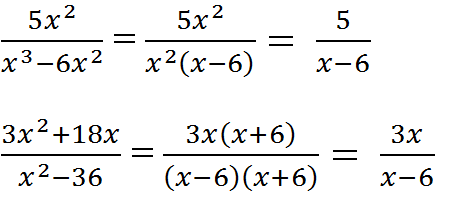Hãy nhập câu hỏi của bạn vào đây, nếu là tài khoản VIP, bạn sẽ được ưu tiên trả lời.

Cả hai bạn đều làm đúng.
- Bạn Tuấn trực tiếp đi tìm mẫu thức chung theo quy tắc:
x3 – 6x2 = x2(x – 6)
x2 – 36 = x2 – 62 = (x – 6)(x + 6)
MTC = x2(x – 6)(x + 6).
- Bạn Lan rút gọn phân thức trước khi đi tìm mẫu thức chung:

MTC = x – 6

Bài 2:
a: \(B=\left(\dfrac{x}{\left(x-2\right)\left(x+2\right)}-\dfrac{6}{3\left(x-2\right)}+\dfrac{1}{x-2}\right):\left(\dfrac{x^2-4+16-x^2}{x+2}\right)\)
\(=\left(\dfrac{x}{\left(x-2\right)\left(x+2\right)}-\dfrac{2}{x-2}+\dfrac{1}{x-2}\right):\dfrac{12}{x+2}\)
\(=\left(\dfrac{x}{\left(x-2\right)\left(x+2\right)}-\dfrac{1}{x-2}\right):\dfrac{12}{x+2}\)
\(=\dfrac{x-x-2}{\left(x-2\right)\left(x+2\right)}\cdot\dfrac{x+2}{12}=\dfrac{-1}{6\left(x-2\right)}\)
b: Thay x=1/2 vào B, ta được:
\(B=\dfrac{-1}{6\cdot\left(\dfrac{1}{2}-2\right)}=\dfrac{-1}{6\cdot\dfrac{-3}{2}}=\dfrac{1}{9}\)
Thay x=-1/2 vào B, ta được:
\(B=\dfrac{-1}{6\cdot\left(-\dfrac{1}{2}-2\right)}=-\dfrac{1}{15}\)
c: Để B=2 thì \(\dfrac{-1}{6\left(x-2\right)}=2\)
=>6(x-2)=-1/2
=>x-2=-1/12
hay x=23/12


a) \(x^2-5x+6< 0\)
\(\Leftrightarrow x^2-2x-3x+6< 0\)
\(\Leftrightarrow x\left(x-2\right)-3\left(x-2\right)< 0\)
\(\Leftrightarrow\left(x-2\right)\left(x-3\right)< 0\)
\(\Leftrightarrow\hept{\begin{cases}x-2>0\\x-3< 0\end{cases}\Leftrightarrow\hept{\begin{cases}x>2\\x< 3\end{cases}}}\)
\(\Leftrightarrow2< x< 3\)
Vậy \(2< x< 3\)là các giá trị cần tìm của bất phương trình
b) \(\frac{2x\left(3x-5\right)}{x^2+1}< 0\)
\(\Leftrightarrow2x\left(3x-5\right)< 0\)(vì \(x^2+1>0\forall x\) )
\(\Leftrightarrow\hept{\begin{cases}2x>0\\3x-5< 0\end{cases}\Leftrightarrow\hept{\begin{cases}x>0\\3x< 5\end{cases}\Leftrightarrow}\hept{\begin{cases}x>0\\x< \frac{5}{3}\end{cases}}}\)
\(\Leftrightarrow0< x< \frac{5}{3}\)
Vậy \(0< x< \frac{5}{3}\)là các giá trị cần tìm của bất phương trình

MÌnh làm tắt mong bạn hiểu
A=5x-x^2 =-(x^2-5x) = -[(x-5/2)^2 -25/4] = -(x-5/2)^2 +25/4 \(\le\) 25/4
Vậy giá trị lớn nhất là 25/4 khi x=5/2
c/4x-x^2+3 =-(x^2-4x+3) = -[(x-2)^2 -1] =-(x-2)^2 +1 \(\le\) 1
Vậy lớn nhất là 1 khi x=2
C= 5-8x-x^2 =-(x^2 +8x-5) = -[(x+4)^2 -21] = -(x+4)^2 +21 \(\le\)21
Vay lớn nhất là 21 khi x=-4

\(\left(4x-1\right)^3-\left(4x-3\right)\left(16x^2+3\right)\)
\(=\left(4x\right)^3-3.\left(4x\right)^2.1+3.4x.1^2-1^3-\left(4x-3\right)\left(16x^2+3\right)\)
\(=64x^3-48x^2+12x-1-64x^3-12x-48x^2-9\)
\(=9\)
Vì kết quả là hằng số nên biểu thức trên không phụ thuộc vào x
b, \(=\frac{x^2+2.5.x+25+x^2-2.x.5+25}{x^2+25}\)
\(=\frac{2x^2+50}{x^2+25}=\frac{2\left(x^2+50\right)}{x^2+50}=2\)

\(1.\)
\(a.=3\left(x+2\right)\)
\(b.=4\left(x-y\right)+x\left(x-y\right)\)
\(=\left(4+x\right)\left(x-y\right)\)
\(c.=\left(x-6\right)\left(x+6\right)\)
\(d.=\left(x^2-2y^2\right)\left(x^2+2y^2\right)\)
\(2.\)
\(a.ĐKXĐ:\)\(x^2-1\ne0\Leftrightarrow x\ne\pm1\)
\(b.A=\frac{3\left(x-1\right)}{\left(x-1\right)\left(x+1\right)}\)
\(=\frac{3}{x+1}với\)\(x\ne\pm1\)
\(c.A=-1\Leftrightarrow\frac{3}{x+1}=-1\)
\(\Rightarrow\left(x+1\right).-1=3\)
\(-x-1=3\)
\(-x=4\)
\(\Rightarrow x=4\left(t/mđk\right)\)
\(d.\)Để \(x\in Z,A\in Z\Leftrightarrow x+1\inƯ\left(3\right)\)
\(Ư\left(3\right)\in\left\{\pm1,\pm3\right\}\)
| x+1 | 1 | -1 | 3 | -3 |
| x | 0 | -2 | 2 | -4 |
Vậy \(x\in\left\{0,-2,2,-4\right\}\)
1a) 3x + 6 = 3 (x + 2)
b) 4x - 4y + x2 - xy = (4x - 4y) + (x2 - xy) = 4 (x - y) + x (x - y) = (4 + x) (x - y)
c) x2 - 36 = x2 - 62 = (x + 6) (x - 6)
2a) phân thức A được xác định khi \(x^2-1\ne0\)
\(\Leftrightarrow\left(x+1\right)\left(x-1\right)\ne0\)
\(\Rightarrow x+1\ne0..và..x-1\ne0\)
\(x\ne-1..và..x\ne1\)
b) \(A=\frac{3x-3}{x^2-1}=\frac{3\left(x-1\right)}{\left(x+1\right)\left(x-1\right)}=\frac{3}{x+1}\)
c) \(A=-1\Rightarrow\frac{3}{x+1}=-1\)
\(\Rightarrow x+1=-3\)
\(x=-4\left(TM\text{Đ}K\right)\)
Vậy x = -1 thì A = -1
#Học tốt!!!
~NTTH~


